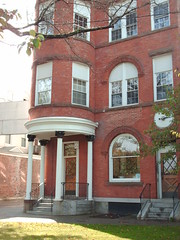
Think you're seeing a lot of these now? You'll be seeing even more of them this year.
On Wednesday night the Danbury Common Council voted 19-2 to allow the Danbury Police Department to be trained by Immigration and Customs Enforcement (ICE) to "handle" undocumented immigrants. The exact details of the deal are not known at this time. The Council voted on the proposal with nothing in writing, as I understand it, so we don't really know just yet exactly what we have committed to do.
I'll be the first to admit that Danbury has problems. But undocumented immigrant workers are just a symptom, not a cause. If we had put the brakes on runaway growth 20 years ago, we wouldn't be where we are today. If we hadn't built the mall, which nearly destroyed the downtown, if we didn't allow developers to build on spec, if we had put the brakes on the McMansions and the condos, if we had supported local farmers instead of forcing them to sell to developers, if we had refused to widen the roads or add any new ones... then Danbury might still be a small town where everyone knows each other. The old stores—Howland's,
the shoe store Markoff's (took me a few hours to remember the name), Woolworth's...—they might still be around. It might be a little boring, but it would be stable. Maybe the kids wouldn't stay here after high school, but I'm not sure they do now anyway.
But stablity doesn't buy a second house on the Cape. Stability doesn't buy that sports car. Stability doesn't put gas in the SUV. And stability doesn't make anyone a millionaire. No, there must be constant—or even accelerating—growth, sort of like a shark. And so that's where we are.
So what does this have to do with immigrant workers and cheap labor? Just who did we think was going to fill the vacuum created downtown by the Mall? Did we think that Danbury would just quietly roll up the streets and die? Well, it came pretty close. There are still a couple of office buildings that have never been fully occupied, having been built at just the wrong time, but are inexplicably still standing. Who did we think was going to maintain the landscapes for all the new developments? And who was going to clean all the new McMansions? Who did we think was going to shop at Wal*Mart? Have you ever walked around downtown New Canaan, Ridgefield, or Redding? Can you even find Redding Center? Can you imagine any of those towns letting developers put condos anywhere there is a sliver of land? Of course not. But Danbury does.
Without cheap immigrant labor, who's going to clean those condos and maintain those yards and build those stone walls? Are we going to bus in unemployed workers from NYC... having first checked their identity papers, of course? Or are we going to stop, take a deep breath, and look at where we are and how we got here?
That's the picture as I see at the local level. At the national level, Jim Hightower has said it better than I ever could, in this article titled
"Immigrants Come Here Because Globalization Took Their Jobs Back There."












